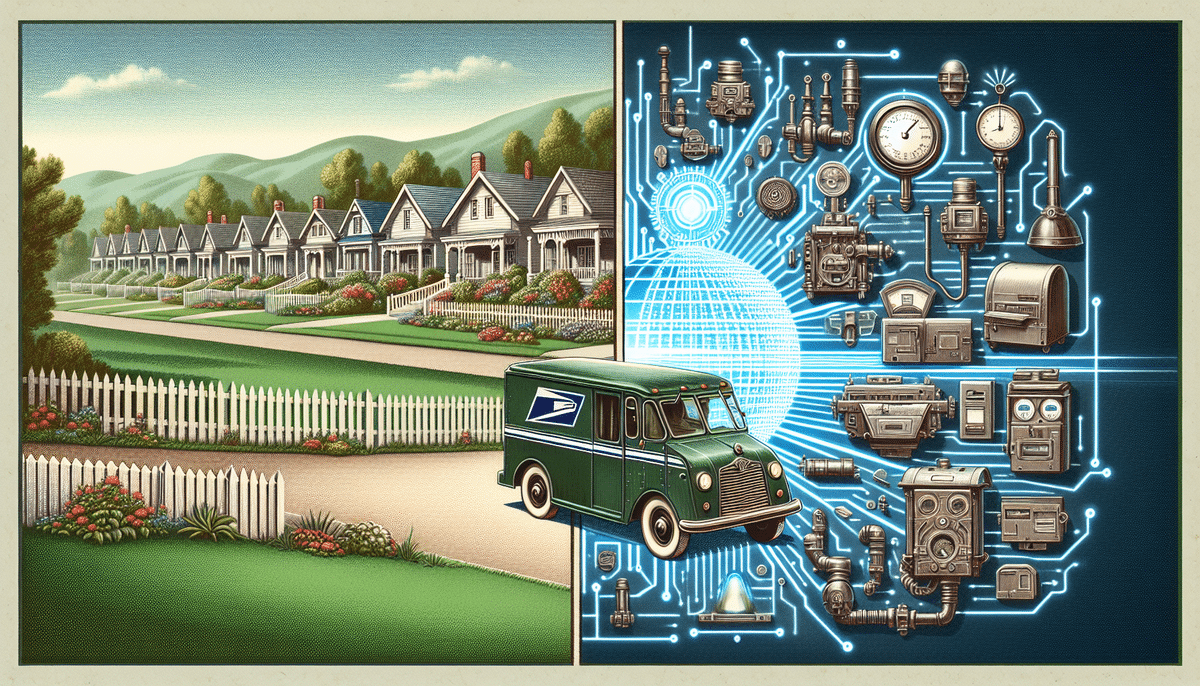USPS vs. Pitney Bowes: A Comprehensive Comparison
When it comes to mailing and shipping, businesses primarily choose between the United States Postal Service (USPS) and Pitney Bowes. Both providers offer a spectrum of services to cater to diverse mailing needs. This article provides an in-depth analysis of USPS and Pitney Bowes, examining their histories, service offerings, pricing structures, customer satisfaction, reliability, and future prospects. By the end, you'll have a clear understanding of which service aligns best with your business requirements.
History of USPS and Pitney Bowes
United States Postal Service (USPS)
Established in 1775 with Benjamin Franklin as its first Postmaster General, the USPS is the United States' oldest federal institution. Over the centuries, it has evolved to handle over 470 million mailpieces daily across 160 million delivery points nationwide. Despite challenges like the rise of digital communication and financial strains, USPS remains a foundational element of American infrastructure.
Pitney Bowes
Founded in 1920, Pitney Bowes began as a postage meter manufacturer. Over the decades, it transformed into a global technology leader in mailing, shipping, and e-commerce solutions. Today, Pitney Bowes operates in over 100 countries, offering innovative services that integrate data analytics, software solutions, and customer engagement tools to streamline mailing operations for businesses.
Services Offered by USPS and Pitney Bowes
USPS Services
- First-Class Mail: Ideal for personal correspondence and lightweight packages.
- Priority Mail: Provides faster delivery with tracking and insurance options.
- Express Mail: Offers overnight delivery to most U.S. locations.
- Parcel Select: Suitable for larger packages with discounted rates for bulk shipments.
- International Shipping: Services like Global Express Guaranteed for global businesses.
- Ancillary Services: PO Boxes, mail forwarding, and Every Door Direct Mail for targeted marketing campaigns.
Pitney Bowes Services
- Postage Meters: Streamlines the mailing process with automated postage solutions.
- Shipping Software: Enhances package tracking and management for businesses.
- Global E-commerce Solutions: Facilitates international trading with seamless shipping integrations.
- Mail Presorting: Improves delivery efficiency and reduces mailing costs.
- Address Validation: Ensures accurate delivery with precise address verification.
- Tracking and Reporting Tools: Provides businesses with actionable insights and real-time tracking data.
Advantages and Disadvantages
Advantages of Using USPS
- Extensive national network ensures widespread accessibility.
- Affordable rates, especially for small and lightweight parcels.
- Bulk mail discounts and specialized services like Every Door Direct Mail.
- Free Saturday delivery enhances delivery speed for businesses.
- Commitment to sustainability through eco-friendly initiatives.
Advantages of Using Pitney Bowes
- Personalized solutions tailored for small and medium-sized enterprises (SMEs).
- Competitive postage rates for both domestic and international shipments.
- Comprehensive mailing and shipping software that streamlines operations.
- Accurate address validation minimizes delivery errors.
- Expert support services for optimizing mailing and shipping workflows.
- Access to training resources to stay updated with industry trends.
Disadvantages of Using USPS
- Limited tracking capabilities compared to private carriers like FedEx and UPS.
- Less cost-effective for large and heavy packages.
- Potential long wait times at post offices during peak seasons.
- Occasional delivery delays impacting customer satisfaction.
- Financial challenges may lead to service cuts or closures.
Disadvantages of Using Pitney Bowes
- Limited accessibility in remote or rural areas.
- Risk of system outages or hardware malfunctions affecting operations.
- Higher costs for small-scale businesses with limited mailing volumes.
- Less flexibility in service offerings compared to USPS.
- Longer processing times for international shipments, potentially delaying business communications.
Cost Comparison Between USPS and Pitney Bowes
USPS Pricing Structure
USPS pricing varies based on the selected service, package size, weight, and destination. For instance, a first-class stamp costs $0.63 as of 2023, while Priority Mail starts at $8.70. USPS also offers bulk mailing discounts and volume-based rates, which can significantly reduce costs for businesses sending large quantities of mail. Additional services like tracking or insurance incur extra fees, and international shipping costs depend on the destination and package weight. For the most accurate pricing, businesses should consult the USPS Price Calculator.
Pitney Bowes Pricing Structure
Pitney Bowes provides various pricing plans tailored to business needs. For example, its SendPro Online service starts at a monthly subscription fee of $4.99, while Postage Meters begin at $19.99 per month. Businesses that send large volumes of mail benefit from volume-based postage rate discounts. Additionally, Pitney Bowes offers customized pricing for international shipments, which can be more economical for businesses with substantial global mailing requirements.
Postage Rates Comparison
Generally, USPS offers more affordable rates for smaller and lighter packages, making it a cost-effective choice for businesses with modest mailing needs. Conversely, Pitney Bowes can provide cheaper rates for larger or bulkier packages, benefiting companies with high-volume shipping requirements. Moreover, comparing the two based on specific business needs—such as delivery speed, package volume, and destination—can help determine the most economical option. Utilizing tools like USPS's Price Calculator and Pitney Bowes's pricing resources can aid in making informed decisions.
Customer Satisfaction and Reliability
USPS Customer Satisfaction
Customer reviews for USPS are mixed. Many appreciate its affordability and extensive reach, but common complaints include lost or delayed packages and inconsistent customer service. According to the 2023 USPS Customer Experience Study, USPS maintains a delivery success rate of 95.4%, though peak seasons like holidays can strain operations.
Pitney Bowes Customer Satisfaction
Pitney Bowes generally receives positive feedback for its personalized solutions and robust support services. However, some users report issues with system reliability and customer support responsiveness. The company's on-time delivery rate stands at an impressive 98.4%, as reported in their 2023 Annual Performance Report.
Reliability of Delivery Services
Both USPS and Pitney Bowes are renowned for their reliable delivery services, boasting high on-time delivery rates. However, USPS may experience occasional delays during high-demand periods, whereas Pitney Bowes maintains a slightly higher reliability score. Businesses should consider these factors, especially if timely deliveries are critical to their operations.
Future Outlook and Growth Potential
USPS Future Prospects
Facing challenges like declining mail volumes due to digital alternatives and financial constraints, USPS is investing in technology to modernize its services. Initiatives such as Informed Delivery and Package Intercept enhance customer experience and operational efficiency. Additionally, USPS is exploring partnerships with e-commerce platforms to capitalize on the growing online shopping trend.
Pitney Bowes Future Prospects
Pitney Bowes continues to innovate by expanding its technology-driven solutions, focusing on data analytics, artificial intelligence, and e-commerce integrations. By leveraging these advancements, Pitney Bowes aims to offer more tailored and efficient services to businesses, maintaining its competitive edge in the mailing and shipping industry. The company's expansion into new markets and continuous product development position it well for sustained growth.
Conclusion: Which Is Better – USPS or Pitney Bowes?
Choosing between USPS and Pitney Bowes depends largely on your business's specific mailing needs. USPS is often more accessible and budget-friendly for small to medium-sized businesses with standard mailing requirements. Its extensive network and affordable rates make it ideal for businesses that don't require advanced tracking or high-volume shipping.
On the other hand, Pitney Bowes excels in providing personalized and technology-driven solutions for larger businesses with substantial mailing and shipping demands. Its advanced software, volume discounts, and high reliability make it a superior choice for businesses seeking efficiency and scalability.
Ultimately, both USPS and Pitney Bowes offer reliable services with distinct advantages. Assessing factors such as package size, mailing frequency, delivery speed, and budget will help determine which service best aligns with your business objectives. By leveraging the strengths of either USPS or Pitney Bowes, businesses can optimize their mailing and shipping operations effectively.




















